Early in her career, Joyce Kozloff gained prominence on both coasts. Here in Los Angeles, as one of the organizers of the 1971 protest of LACMA’s white-male-dominated exhibition record, she became an early proponent of feminist art. Four years later, she joined Miriam Schapiro, Bob Zakanitch and a handful of other artists to found the Pattern and Decoration movement in New York. In the late 1970s, Kozloff crossed the high art/low art divide when she began painting on tiles instead of canvas. She went on to spend two decades engaged in public art, creating tile-based walls, plazas, and subway stations across the United States and abroad. (Southern California readers will be most familiar with her tiled plaza las Fuentes in Pasadena and her metro stop at 7th and Flower in Los Angeles.) Kozloff segued from public art back to studio work, using maps to make powerful political statements about imperialism and warfare. Most recently, she has turned her eclectic, trans-media eye to Chinatown kitsch, the Ebstorf Map, and vintage French school maps.
Kozloff has been exhibiting regularly, to remarkable critical acclaim, for more than four decades. I spoke to her twice, in July via telephone from her New York studio and September when she came to CB1 Gallery in downtown LA, where she has a show planned for January–February 2013.
BETTY ANN BROWN: Kozloff may be best known as one of the founders of the Pattern and Decoration Movement. I ask her to speak about it.
JOYCE KOZLOFF: It was New York, 1975. Miriam Schapiro invited me to a meeting at Bob Zakanitch’s loft. There were several other people there, including art writer Amy Goldin and artists Tony Robbin and Robert Kushner. Later, there were more meetings and more people joined us.
I was excited about two discussions in those early meetings: one, that we were defining ourselves in opposition to the dominant minimalist style; and two, that all of us were exploring the impact of non-Western art.
When we began getting a lot of attention, I went around the country giving lectures on the movement. Often, there were weavers and potters in the audience. I thought we were paying homage [to their art forms], breaking down the barriers [between high art and low art]. But again and again, they said, Yeah, but you’re still making paintings. Why don’t you weave baskets? Or whatever.
I heard it so many times. Then one day I really heard it and decided I must begin working in the decorative arts. I couldn’t justify the ideology of breaking down the hierarchy by simply incorporating decorative motifs into painting any longer.
I point out that she paints now.
I’ve always painted. Whether I paint on tiles or on canvas, the brush has been my primary tool. However, I stopped painting on canvas in 1977 and worked in other media for 20 years. Now I paint on canvas. I also paint on panels, paper and fabric. I draw and do collage. For me, there are no hierarchies among media. I don’t call myself a painter. I call myself an artist.
The recent, more politically engaged work has a different kind of content than the pattern-based work of the 1970s and ’80s. I ask Kozloff to talk about that shift.
I’ve always been a political artist. For me, the decorative work was political and provocative. People are not offended by it now, but they were at the time.
I sent my first decorative painting [Three Facades (1973)] to [New York gallerist] Tibor de Nagy and he hung it in a back room. One day, he told me Clement Greenberg had been in and said it looked like ladies’ embroidery. Tibor’s hands were shaking and his voice was quivering when he [told me] this, and he sent the piece back to my studio. Tibor exhibited the painting once he got used to it, but at that time, Greenberg’s formalist ideology was still quite powerful.
Kozloff focused on public art from 1983 through 2003. I ask her what initiated the move from public art back to the studio.
When I was doing public art, I hand-painted all the tiles. Each project would take over my life for a year. Meanwhile, I had other ideas, but I never had time to get to them…
For every public art project, I was given floor plans or blueprints of the site. I saw the plans as the scaffolding of the building; the art I layered onto them was the skin. One day it occurred to me that this could be an interesting process for my private work. Soon after, I began to copy city maps from atlases, weaving into them ideas and images that I associated with those places.
The mapping work takes time. If you’re an MTV person, you may not get it, because you may not spend enough time with it.
I’ve seen people come into one of my shows, where there’s a lot of very, very dense work, glaze over and walk out. Other people will stand in front of each piece and really look at it.
We’ve grown up thinking that political art looks a certain way, black and white, or expressionistic and harsh, and my work isn’t like that. Unless you come up close, you may not even see the politics. It might look pretty or decorative—that’s my aesthetic—so there’s something dissonant there.
I ask Kozloff about China is Near (2010), which exists as original artworks and a related book.
I was planning to travel the Silk Road in China with two friends, but my brother became terminally ill and I didn’t want to be far away. So I started walking to Chinatown, which is a few blocks from my house.
The title of the series comes from Marco Bellocchio’s film La Cina é vicina, which is not about China but about Marxists in Rome. My own work is not about China, but about Chinatowns.
I began by copying maps of the Silk Road out of books—the books I had bought for my travels. I added collage elements like cut-tissue papers from China. Then I bought my first camera—I never took photographs before and don’t know if I will again—and shot the pictures in Chinatown. And I downloaded and printed from Google maps all the places in the world called China. The series is a combination of collage, drawing, photographs, and those Google maps.
I mention Barthes’ Empire of Signs, which is about the Western idea of Japan, just as her work is about the Western idea of China.
I loved Barthes’ book. I also read about Chinatowns when I was doing the series. Chinatown as a concept was invented in San Francisco after the 1906 earthquake. The Chinese community wanted to make something that would be commercially viable and deter discrimination. It was a big success. And it’s been copied all over the world. Someone told me they’re making a Chinatown theme park in China now.
China is near. China is everywhere.
I ask her what came after China is Near.
I did this big painting JEEZ (2012). Marcia Kupfer, an expert in medieval maps, spoke to me about the Ebstorf Map. The original was 12 feet in diameter, so I made my piece at that scale, in 36 two-foot square sections. I quickly realized that the body of Christ was embedded in the map. So I Googled Jesus images: Jesus gay, Jesus Asian, Jesus African, Jesus as a woman, and a plethora of stuff came out. Ultimately, I added over a hundred images to the piece—everything from Old Masters to kitsch. I loved working on it; I think it’s very funny.
I ask her how it felt to work on Jesus, since she came from a Jewish background.
In my hometown, we were practically the only Jewish family. Everyone else was Catholic. When I started working on JEEZ, I thought, oh my God, this guy has been with me all my life, everywhere I looked. My first love when I started studying art seriously was the Italian Renaissance and there’s a preponderance of Renaissance imagery in JEEZ. I didn’t do justice to it. But I certainly didn’t degrade it.
The piece is also my response to what is going on politically in this country. The escalating rhetoric of religion in our political life is disgusting to me, particularly the imposition of Christianity. Jeez was my way of dealing with that.
Finally, the most recent body of work, Social Studies.
I found these French school maps at a flea market in Paris. They were printed in the 1950s and early 1960s. They depict different countries and continents, as well as different regions of France. They’re very charming, with animals, plants, factories, and people on them.
This summer, I worked with Fran Flaherty in Carnegie Mellon’s new digital print lab. We scanned the existing maps and layered new content onto them. I wanted to introduce subjects that might not be taught in geography or history classes, and to question the way children are educated. There’s information about elections, about history, about native populations, about natural resources, about wars. There are 17 in the series. We printed them digitally, at 36” x 30” in editions of five each.
The series is rich and dense, a great way to pictorialize the intersections of history and geography. I ask her where the work will go now.
Who knows? I may take the school maps in a completely different direction.
Who knows, indeed? With an artist whose vision ranges over such large, complex territories, there is no way to predict where Kozloff’s oeuvre will travel next.





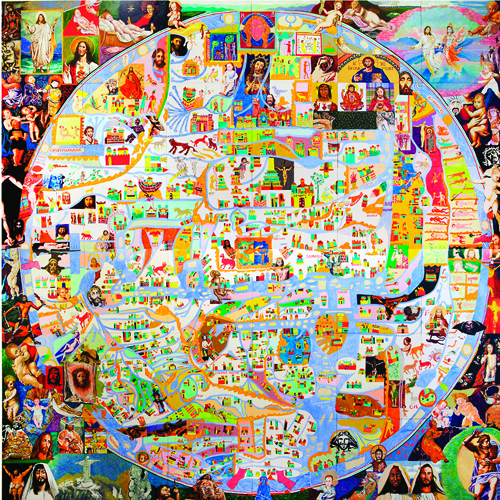
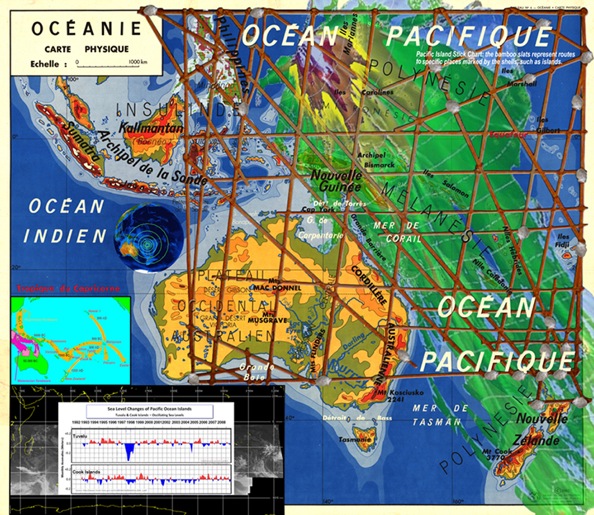
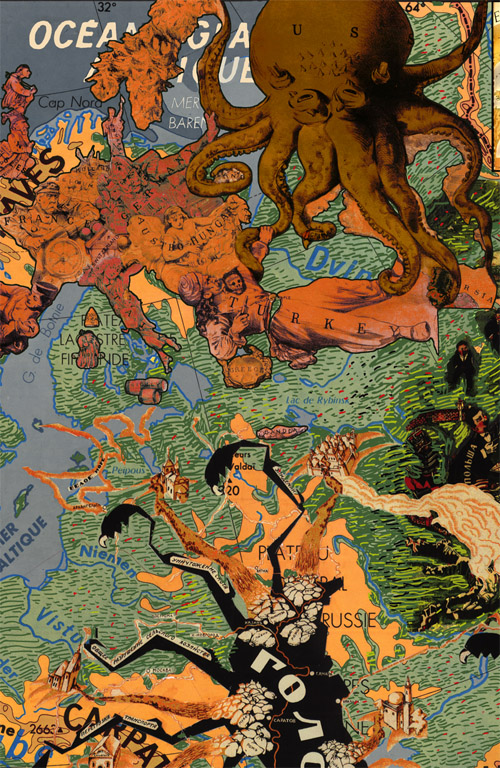
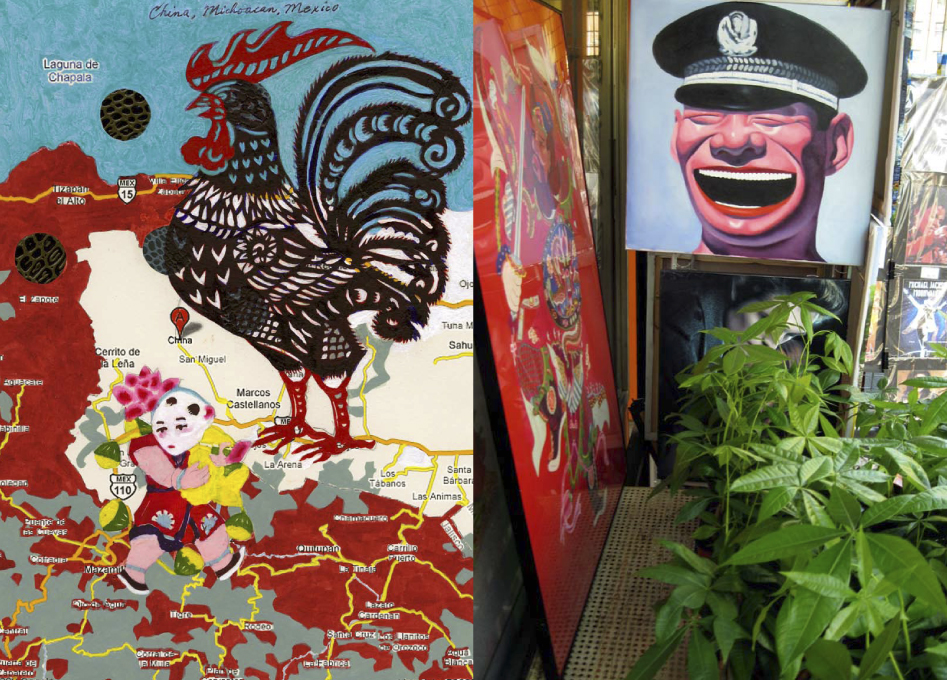
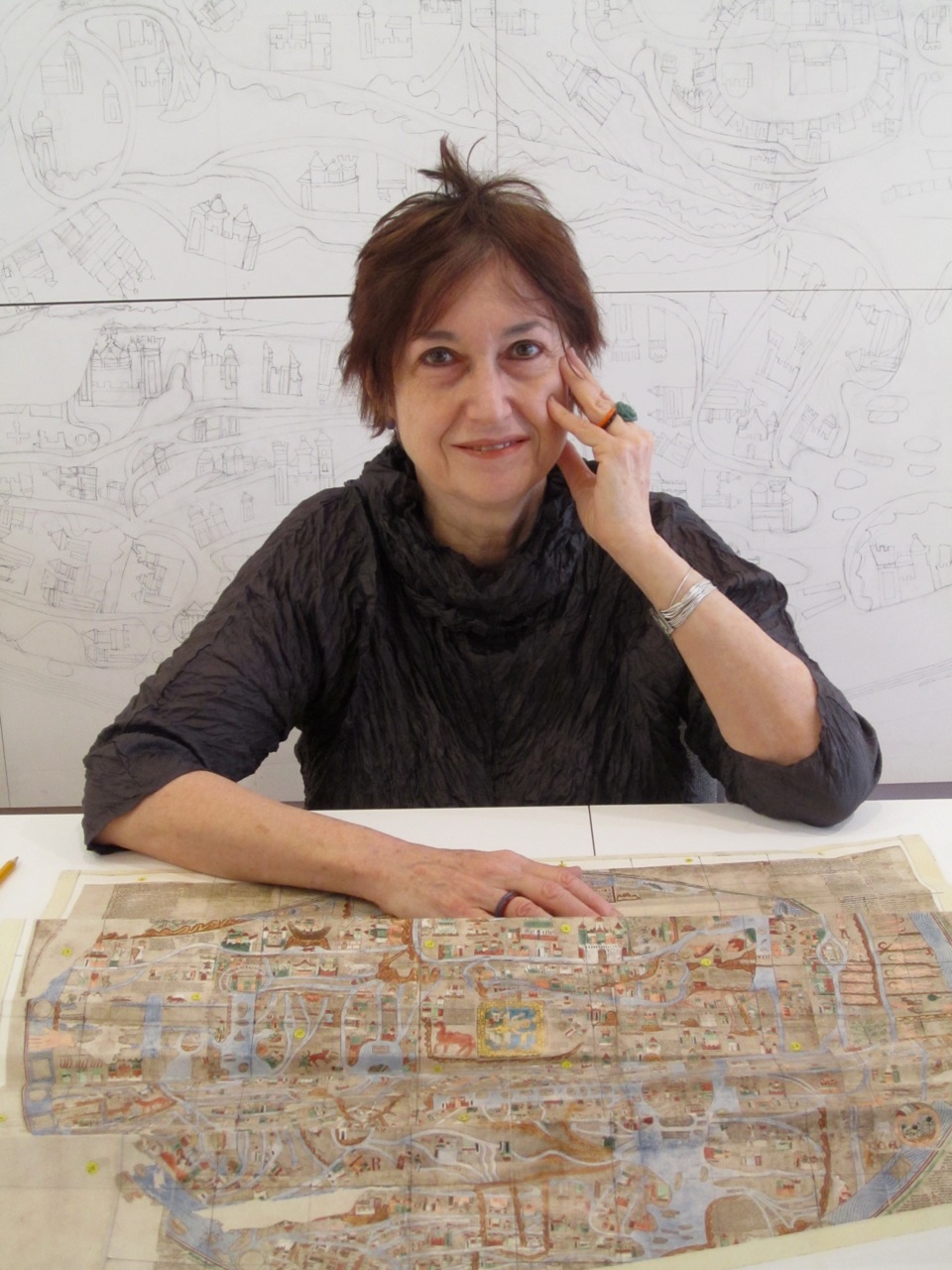













0 Comments